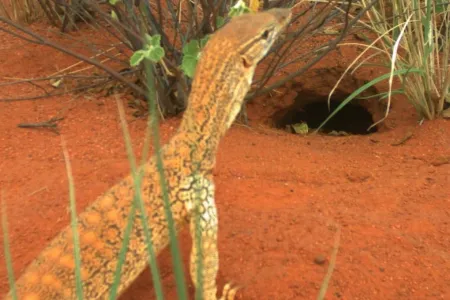Our focus
Our research is centred on the ecology, sustainable management and conservation of wildlife in arid Australia.
We investigate the processes that shape temporal and spatial distribution of fauna, and interactions between native plants and animals, especially in relation to climate, fire, and the widespread transformation of arid Australian ecosystems by introduced pastoral grasses.
Specialist expertise and tech
We specialise in reptile, bird and mammal ecology, vegetation and fire ecology. We collaborate widely with ecologists and social researchers from across Australia and work across disciplines. Our cross disciplinary work and research with Aboriginal groups aims to support the reconciliation of economic, social and conservation goals in central Australia.
Why this research is important
Over 70 per cent of mainland Australia is arid or semi-arid. This vast region is a globally significant for biodiversity, representing one of the largest remaining areas on earth with relatively intact ecology. Even so, biodiversity in these dry inland areas are subject to major threats including changing fire regimes caused by introduced grasses and climate change, feral animals and overgrazing by feral and domestic herbivores and the region has suffered from very high rates of extinction, especially of mammals.
Effective sustainable management of Australia’s arid ecosystems requires improved understanding of the changing processes impacting on ecological systems, and of how to overcome challenges including a very low population, vast distances, low resourcing and the social and economic disadvantage of Aboriginal peoples who make up the majority of the population in remote areas. Research that reconciles economic, social and conservation goals is particularly required.
Key achievements and impacts
- We collaborate with government land management agencies, Industry, private landholders and Indigenous organisations and groups in central Australia – most of our research is directly responsive to concerns and requirements for information expressed by these stakeholder groups to help inform wildlife and natural resources management.
- We achieve a high level of engagement with the community through public forums, talks and information sharing to a wide range of audiences including conservation and land management practitioners, remote indigenous groups and the general public.
- Our work has high academic impact and is published in high-impact journals.
Key projects
More than a burning issue: Does grass invasion disrupt plant-animal interactions and threaten persistence of semi-arid woodland communities?
This research aims to determine how buffel grass (Cenchrus ciliaris) invasion affects population and recruitment dynamics of keystone woody perennial plants that are characteristic of riparian woodlands in central Australia, and identify whether recruitment is disrupted by invasion-induced shifts in plant-animal interactions. This is a collaborative project with University of Wollongong and CSIRO and funded by the Hermon Slade Foundation.
Does Buffel Grass (Cenchrus ciliaris) invasion impact plant-animal interactions in an arid system?
This PhD project investigates the impact of buffel grass invasion on plant and animal communities in the Anangu Pitjantjatjara Yankunytjatjara (APY) lands of north western South Australia, and interactions between native and invasive plants and granivorous animals, focussing on culturally important species.
Buffel grass has taken over large areas of country on the APY lands, with significant risk to biodiversity, Anangu culture, and community assets. This project responds to requests from Anangu for more information on the major landscape changes that they see, and has a strong community engagement component.
The research is funded by a Holsworth Wildlife Research Endowment, Jill Landsberg Trust Fund, Ten Deserts and Alinytjara Wilurara Natural Resources Management and generously supported by APY Land Management.
Temporal and spatial patterning in bird and bat assemblages in riparian woodlands of central Australia
This PHD project investigates the temporal and spatial dynamics of bird and bat populations in the river red gum woodlands that characterise riparian systems in central Australia.
The research seeks to understand changes in the composition and abundance of birds and bats in riparian woodland compared to adjacent shrubland under different seasonal and rainfall conditions, and tests whether these relate primarily to habitat differences or fluctuating resources.
Potential threats to riparian woodlands and the key habitat attributes they provide, caused by increased intensity and frequency of fire, premise this research. Supported by Birdlife Australia Ltd. and the Australian Bat Society.
